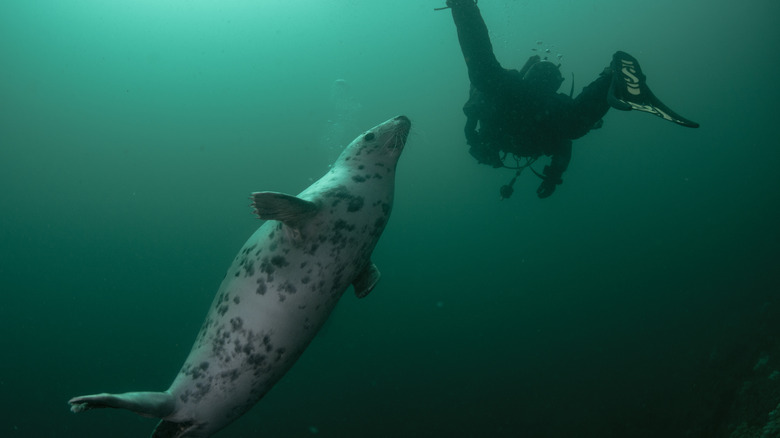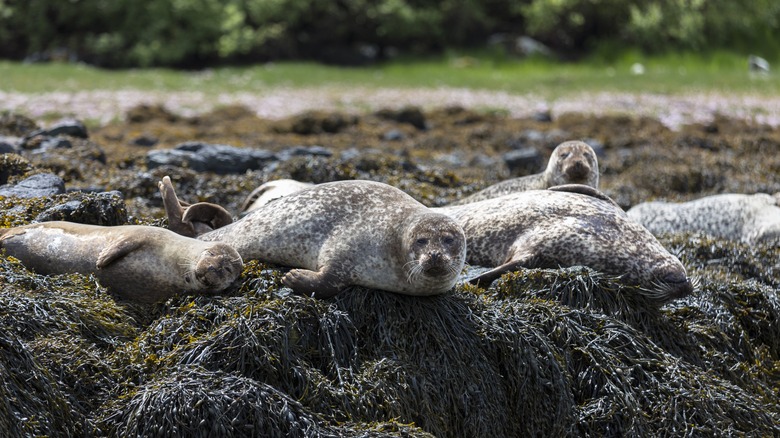The Best Thing To Do If A Seal Comes Near You While Scuba Diving
"In the green haze of the plankton bloom, I'm suddenly seeing this shape and it's coming closer ... and there she is ..." biologist Lisa Kelly told National Geographic. She was in the frigid waters of Antarctica and face to face with a 13-foot-long leopard seal that seemed fascinated by her and her camera. While leopard seals have attacked and once even killed a human swimming alongside them, that's not the norm — and certainly wasn't the case with Kelly's encounter. "It was like she was playing. She was certainly not aggressive, but very, very curious."
If you love slipping into your wetsuit and diving into coastal waters almost anywhere on the planet, there's a chance you might come into contact with a seal. Seals can be playful and like to learn about unusual things in their environment — like you! They may follow you, bump into you, or even put your flippers in their mouths. If that happens, don't panic. Unlike when you see a shark while scuba diving, you shouldn't make sudden movements and try to startle the animal away. Staying calm and still is imperative. Don't splash your way back to shore as fast as possible, and definitely don't reach out and pet them. Typically, if you just calmly watch the seal while it swims around you, it will determine that you're no threat and swim away on its own, leaving you safe and with a treasured lifelong memory.
Give the seals space on land and in the ocean
Whenever possible, leave any seals you spot while scuba diving alone to do their own thing. If you spot seals on the shore or lounging on rocks, feel free to watch them from where you are, but don't get too close. If they get stressed out, they may rush back to the ocean, hurting themselves in the process. This is true at all times, but especially in fall, winter, or the very beginning of spring when they might have babies. Be particularly sure to never block them from getting back to the water. If you suspect a seal is unsafe, sick, or injured, alert local wildlife organizations in your area (like The Marine Mammal Care Center in the U.S. or British Divers Marine Life Rescue in the U.K.)
Sometimes, however, seals may approach you in the water. In that case, all you need to do is stay calm, stay where you are, or slowly make your way back to shore. Do what you can not to alarm the seal, and you can get a good look at each other without either getting hurt. If the seal is splashing around, diving, or it seems like it's getting angry or upset with you, make your way back to shore as slowly and deliberately as you can, giving the seal plenty of space. Remember, never intentionally touch or pet a seal — let the seal decide how much contact you have.
Places you might encounter seals
You don't have to be so adventurous as to go diving in freezing Antarctic waters to encounter seals in the water. Although you shouldn't hop on a plane immediately after scuba diving, flying around the world to explore the oceans is a thrilling proposition — and you're bound to meet some seals in the process. Many of the best coastal waters for scuba diving around the world also happen to be home to seals.
For instance, if you happen to be soaking in the sun in a vibrant South African coastal village, you might encounter fluffy Cape fur seals. You will likely spot harbor seals or gray seals on Cape Cod in the United States (though you should probably avoid swimming with them, as their natural predator — the great white shark — can often be found swimming in those same waters). If you visit Hawaii or the Mediterranean, you might be lucky enough to spot a severely endangered species of monk seal, but do everything you can to give these shy creatures space if you happen to see them swimming by you.

